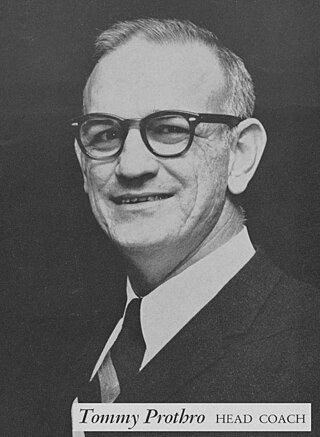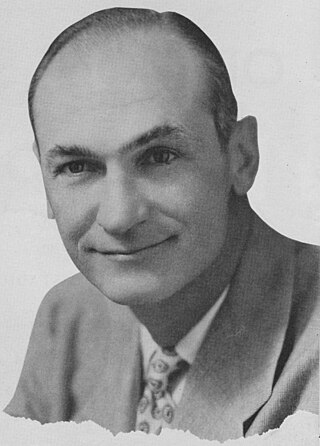
The Oregon State Beavers football team represents Oregon State University in NCAA Division I FBS college football. The team first fielded an organized football team in 1893 and is a member of the Pac-12 Conference.

The 1960 Oregon State Beavers football team represented Oregon State College as an independent during the 1960 college football season. In their sixth season under head coach Tommy Prothro, the Beavers compiled a 6–3–1 record and outscored their opponents 197 to 145. They played two home games on campus at Parker Stadium in Corvallis and two at Multnomah Stadium in Portland.
The 1959 Oregon State Beavers football team represented Oregon State College as an independent during the 1959 college football season. In their fifth season under head coach Tommy Prothro, the Beavers compiled a 3–7 record and were outscored 178 to 166. Oregon State played three home games on campus at Parker Stadium in Corvallis and one at Multnomah Stadium in Portland.

The 1958 Oregon State Beavers football team represented Oregon State College in the Pacific Coast Conference (PCC) during the 1958 college football season. In their fourth season under head coach Tommy Prothro, the Beavers compiled a 6–4 record, and were outscored 98 to 118. They played three home games on campus at Parker Stadium in Corvallis and two at Multnomah Stadium in Portland.

The Pacific Coast Conference Oregon State Beavers football team represented Oregon State College in the Pacific Coast Conference (PCC) during the 1954 college football season. In their sixth and final season under head coach Kip Taylor, the Beavers compiled an overall record of 1–8 with a mark of 1–6 conference play, tying for eighth place in the PCC, and were outscored 296 to 60. The team won the opener at home against Idaho, but then had eight consecutive losses. The Beavers played three home games on campus at Parker Stadium in Corvallis, with one at Multnomah Stadium in Portland.

The 1953 Oregon State Beavers football team represented Oregon State College as a member of the Pacific Coast Conference (PCC) during the 1953 college football season. In their fifth season under head coach Kip Taylor, the Beavers compiled an overall record of 3–6 record with a mark of 3–5 in conference play, placing sixth in the PCC. The team was outscored 187 to 39 on the season. Oregon State opened with five shutout losses, then visited and shut out the Idaho Vandals, 19–0, for their first points and win.

The 1952 Oregon State Beavers football team represented Oregon State College as a member of the Pacific Coast Conference (PCC) during the 1952 college football season. In their fourth season under head coach Kip Taylor, the Beavers compiled an overall record of 2–7 with a mark of 1–6 in conference play, placing last out of nine teams in the PCC, and were outscored 267 to 123.

The 1930 Oregon State Aggies football team represented Oregon State College in the Pacific Coast Conference (PCC) during the 1930 college football season. In their seventh season under head coach Paul J. Schissler, the Beavers compiled a 7–3 record, finished in sixth place in the PCC, and outscored their opponents, 208 to 60. The team played its home games at Bell Field in Corvallis, Oregon.
The 1929 Oregon State Aggies football team represented Oregon State University in the Pacific Coast Conference (PCC) during the 1929 college football season. In their sixth season under head coach Paul J. Schissler, the Beavers compiled a 5–4 record, finished in a tie for seventh place in the PCC, and outscored their opponents, 182 to 106. Under coach Schissler, from 1925 to 1932, no team captains were elected. The team played its home games at Bell Field in Corvallis, Oregon.
The 1928 Oregon State Aggies football team represented Oregon State University in the Pacific Coast Conference (PCC) during the 1928 college football season. In their fifth season under head coach Paul J. Schissler, the Aggies compiled a 6–3 record and outscored their opponents 206 to 53. Under coach Schissler, from 1925 to 1932, no team captains were elected. The team played its home games on campus at Bell Field in Corvallis, Oregon.
The 1927 Oregon State Aggies football team represented Oregon State University in the Pacific Coast Conference (PCC) during the 1927 college football season. In their fourth season under head coach Paul J. Schissler, the Aggies compiled a 3–3–1 record and outscored their opponents 98 to 78. Under coach Schissler, from 1925 to 1932, no team captains were elected. The team played its home games on campus at Bell Field in Corvallis, Oregon.
The 1926 Oregon Agricultural Aggies football team represented Oregon Agricultural College in the Pacific Coast Conference (PCC) during the 1926 college football season. In their third season under head coach Paul J. Schissler, the Aggies compiled a 7–1 record and outscored their opponents 221 to 30. Under coach Schissler, from 1925 to 1932, no team captains were elected. The team played its home games on campus at Bell Field in Corvallis, Oregon.
The 1925 Oregon Agricultural Aggies football team was an American football team that represented Oregon Agricultural College in the Pacific Coast Conference (PCC) during the 1925 PCC football season. In its second season under head coach Paul J. Schissler, the Aggies compiled a 7–2 record and outscored its opponents 268 to 81. Under coach Schissler, from 1925 to 1932, no team captains were elected. The team played its home games on campus at Bell Field in Corvallis, Oregon.

The 1923 Oregon Agricultural Aggies football team represented Oregon Agricultural College in the Pacific Coast Conference (PCC) during the 1923 college football season. In their fourth and final season under head coach Red Rutherford, the Aggies compiled a 4–5–2 record and were outscored 71 to 55. Tackle Percy Locey was the team captain; the team played its home games on campus at Bell Field in Corvallis, Oregon.

The 1922 Oregon Agricultural Aggies football team represented Oregon Agricultural College in the Pacific Coast Conference (PCC) during the 1922 college football season. In their third season under head coach Red Rutherford, the Aggies compiled a 3–4 record and outscored their opponents 44 to 42. Fullback Gap Powell was the team captain, and home games were played on campus at Bell Field in Corvallis, Oregon.

The 1921 Oregon Agricultural Aggies football team represented Oregon Agricultural College in the Pacific Coast Conference (PCC) during the 1921 college football season. In their second season under head coach Red Rutherford, the Beavers compiled a 4–3–2 record, finished in fourth place in the PCC, and outscored their opponents, 231 to 42. Chuck Rose was the team captain. Fullback Gap Powell was selected as an All-American by Football World and Athletic World. The team played its home games at Bell Field in Corvallis, Oregon.
The 1919 Oregon Agricultural Aggies football team represented Oregon Agricultural College in the Pacific Coast Conference (PCC) during the 1919 college football season. In their second and final season under head coach Homer Woodson Hargiss, the Aggies compiled a 4–4–1 record, finished in last place in the PCC, and outscored their opponents by a combined total of 143 to 64. The team played its home games at Bell Field in Corvallis, Oregon. Raymond Archibald was the team captain.
The 1918 Oregon Agricultural Aggies football team represented Oregon Agricultural College in the Pacific Coast Conference (PCC) during the 1918 college football season. In their first season under head coach Homer Woodson Hargiss, the Aggies compiled a 2–4 record, finished in last place in the PCC, and were outscored by their opponents by a combined total of 46 to 33. The team played its home games at Bell Field in Corvallis, Oregon. Meier Newman was the team captain.
The 1917 Oregon Agricultural Aggies football team represented Oregon Agricultural College in the Pacific Coast Conference (PCC) during the 1917 college football season. In their second and final season under head coach Joseph Pipal, the Aggies compiled a 4–2–1 record, finished in third place in the PCC, and outscored their opponents by a combined total of 83 to 33. The team played its home games at Bell Field in Corvallis, Oregon. Lee Bissett was the team captain.
The 1916 Oregon Agricultural Aggies football team represented Oregon Agricultural College in the Pacific Coast Conference (PCC) during the 1916 college football season. In their first season under head coach Joseph Pipal, the Aggies compiled a 4–5 record, finished in third place in the PCC, and were outscored by their opponents by a combined total of 112 to 92. The team played its home games at Bell Field in Corvallis, Oregon. Brewer Billie was the team captain.






